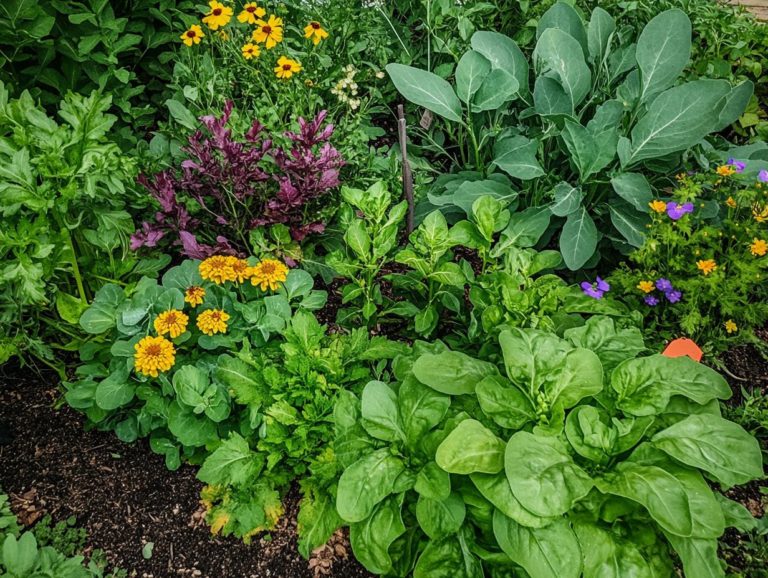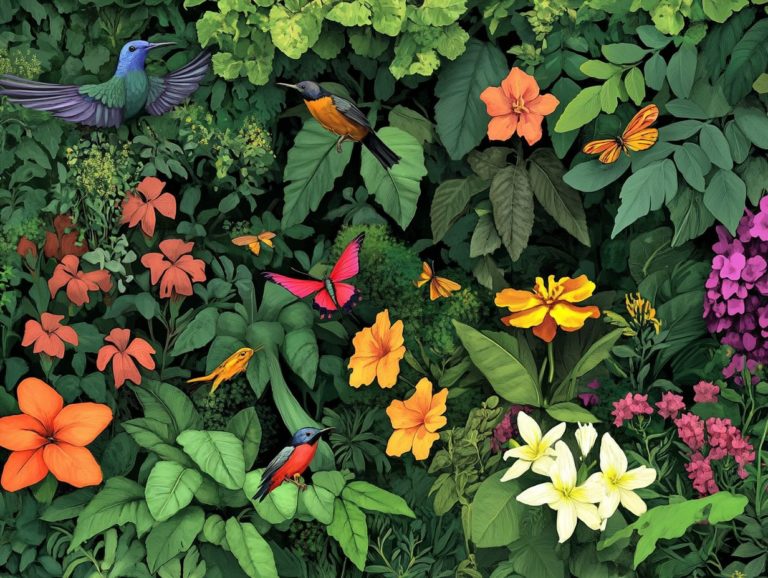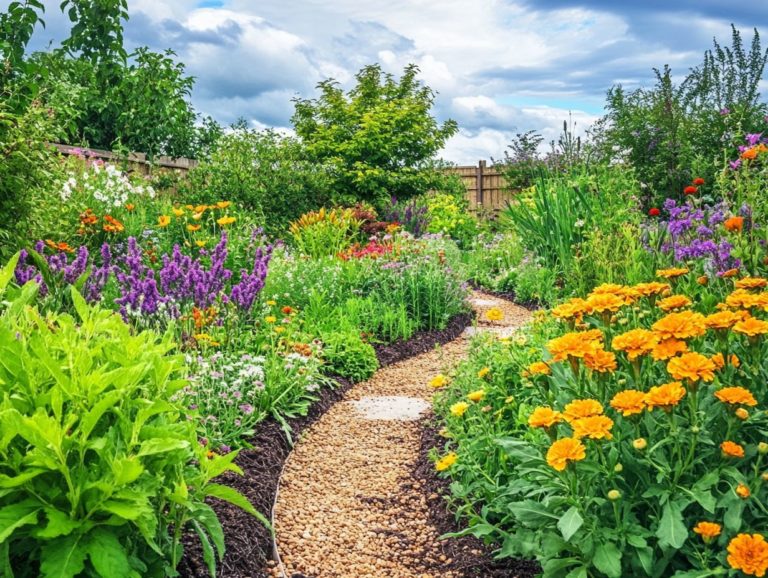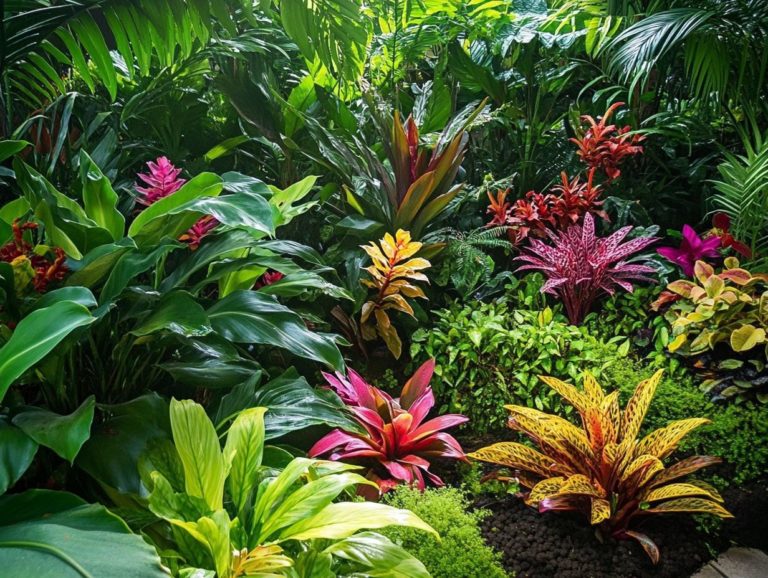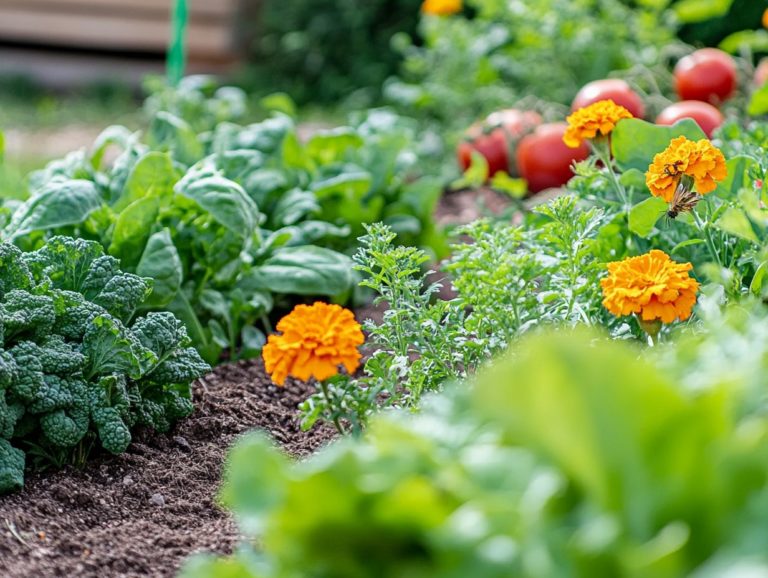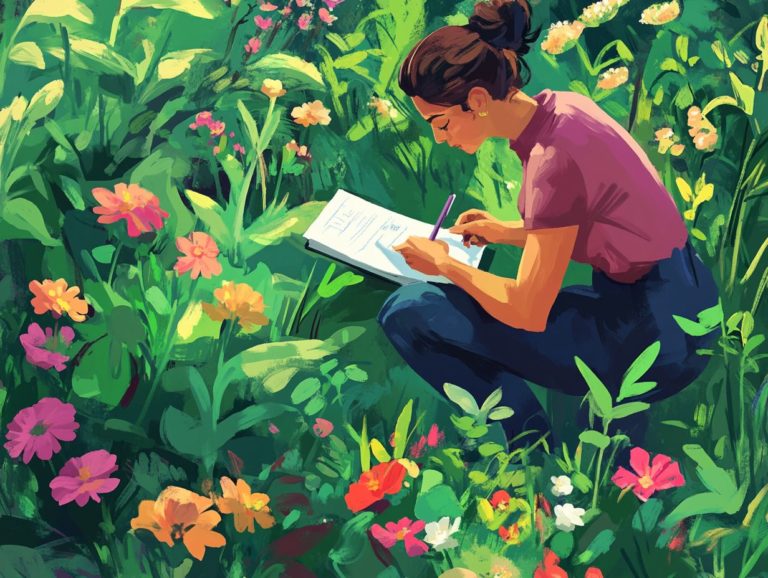“How to Select Plants for a Perennial Garden”
Creating a perennial garden is a rewarding journey into the world of nature. You can enjoy beauty and sustainability year after year.
This guide introduces you to the wonders of perennial plants and their numerous benefits, including easy care and the charm of attracting pollinators.
You ll explore key factors to consider when selecting the right plants for your garden. Discover various types of perennials and gather tips for designing and maintaining your lush sanctuary.
Dive in to learn how to cultivate a garden that thrives beautifully through the seasons!
Contents
- Key Takeaways:
- Understanding Perennial Gardens
- Benefits of a Perennial Garden
- Factors to Consider When Choosing Plants
- Types of Perennial Plants
- Designing Your Perennial Garden
- Tips for Maintaining a Perennial Garden
- Frequently Asked Questions
- How do I select the right plants for my perennial garden?
- What are some low-maintenance plants that are suitable for a perennial garden?
- How can I ensure my perennial garden has color all year round?
- What are some ways to incorporate variety in my perennial garden?
- How can I make sure my perennial garden is sustainable?
- What are some must-have plants for a beginner’s perennial garden?
Key Takeaways:
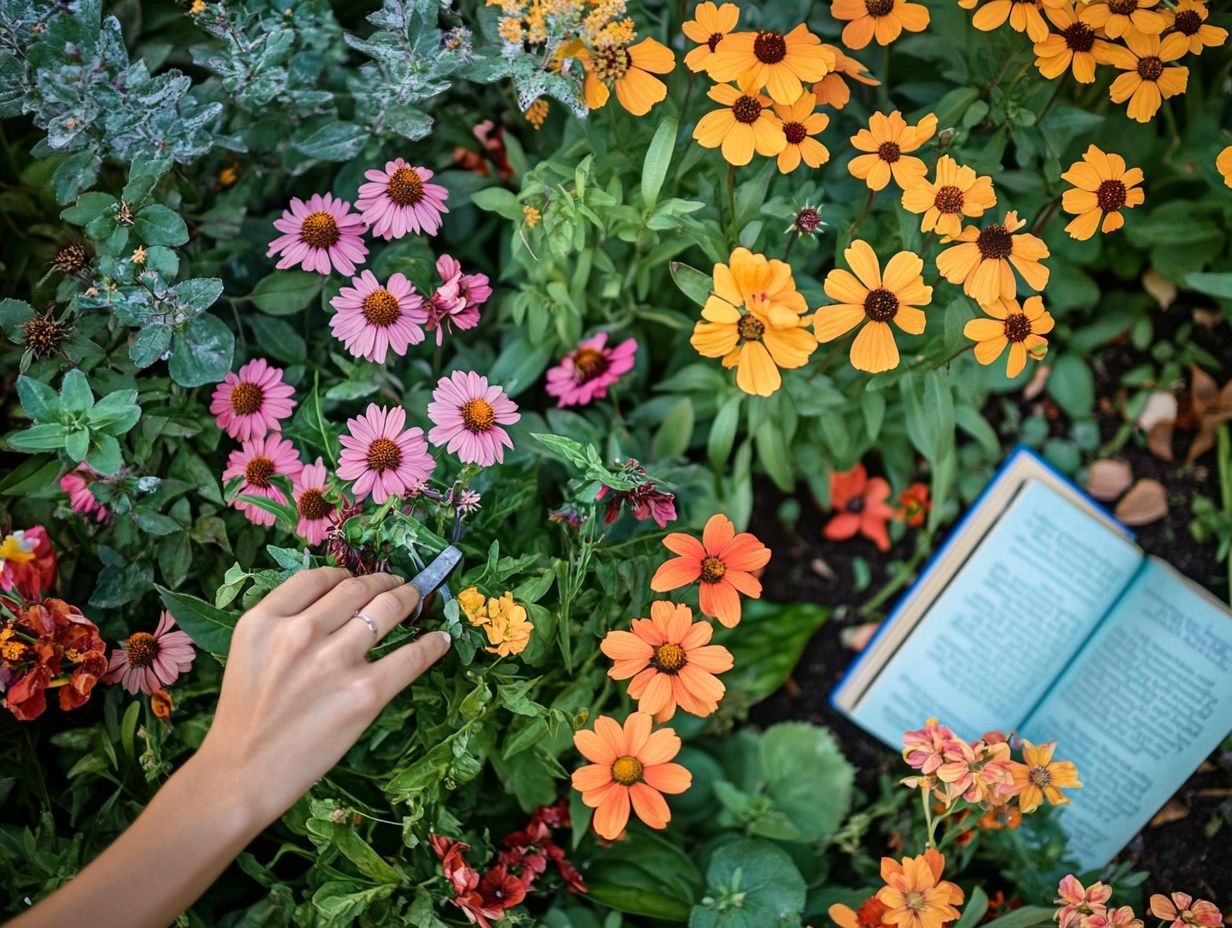
- Choose perennial plants based on your climate and soil conditions for optimal growth.
- Perennial gardens are easy to take care of and cost-effective, attracting pollinators and wildlife to your outdoor space.
- When designing your garden, consider color, height, and bloom time. Create a layout with complementary plants for a vibrant look.
Understanding Perennial Gardens
To truly grasp the essence of perennial gardens, you must explore their fundamental elements. This includes the diverse array of perennial plants that thrive in different climates and soil conditions.
These gardens require easy care and serve as a sanctuary for pollinators and wildlife. With thoughtful selection, you can craft breathtaking landscapes that enhance the ecosystem year after year. This creates a harmonious balance between beauty and nature.
What are Perennial Plants?
Perennial plants are your best friends in the garden. They live for more than two years and return reliably each growing season. They re a sustainable choice for anyone looking to create lasting beauty in their outdoor space.
These remarkable plants flourish year after year and require less effort compared to annuals. With roots that go deep into the soil, they can better handle drought conditions and improve soil health.
You ll find a wide variety of perennials to choose from. Options range from ornamental flowers like peonies and daisies to lush foliage varieties such as hostas and ferns. Consider adding popular options like lavender, celebrated for its fragrant blooms, or echinacea, known for its resilience and vibrant colors.
By embracing perennials, you can transform your garden into a dynamic yet easy-to-care-for landscape, offering rich textures and stunning visuals in every season.
Benefits of a Perennial Garden
The advantages of a perennial garden are abundant. You’ll enjoy easy care, allowing you to spend time on enjoyment rather than upkeep.
Over the long term, it proves to be cost-effective, letting you invest in your garden without breaking the bank. A well-planned perennial garden attracts various pollinators and wildlife, fostering a vibrant ecosystem right in your backyard.
Low Maintenance and Cost-Effective
A perennial garden is your ticket to low maintenance bliss. You can enjoy its beauty without the relentless upkeep that annual plants require. It s a cost-effective solution for busy lives.
This type of garden flourishes with minimal fuss. These resilient plants return year after year, meaning fewer replanting sessions and more time saved for you. Perennials need less watering, fewer fertilizers, and little pruning.
Simple care techniques like mulching can work wonders suppressing weeds, retaining moisture, and enhancing soil quality. This leads to healthier plants with far less effort on your part.
By investing in a thoughtfully planned perennial garden, you not only save money on gardening supplies but also on labor. This makes it a wise and sustainable choice for anyone juggling a packed schedule.
Start your journey to creating a stunning perennial garden today!
Attracting Pollinators and Wildlife
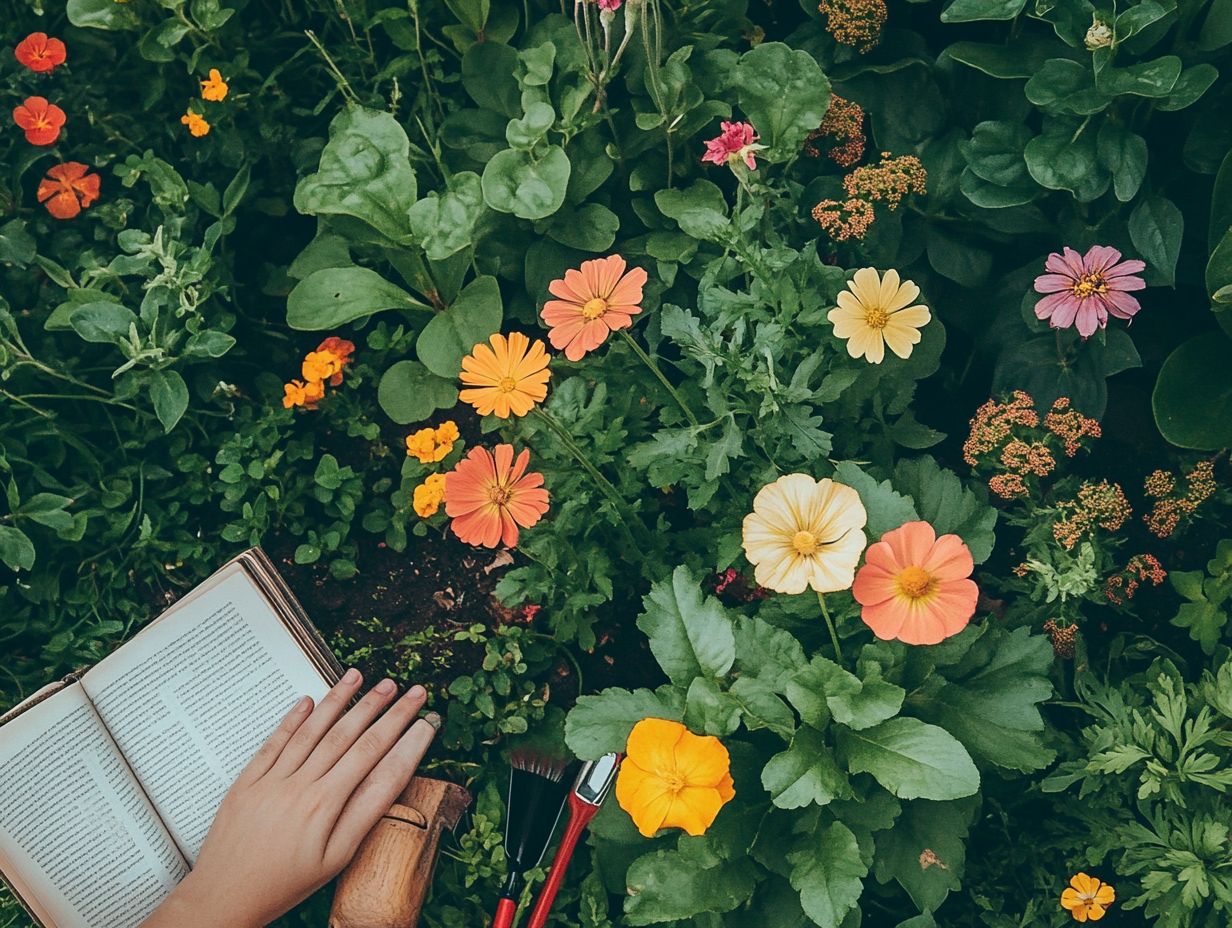
One of the standout benefits of cultivating a perennial garden is its remarkable ability to attract pollinators and wildlife. This enhances biodiversity by creating essential habitats and food sources for various species.
Consider plants like coneflowers, bee balm, and black-eyed Susans. These vibrant blooms are inviting beacons for bees and butterflies, drawing them in with their colorful petals and sweet nectar.
These perennials bloom at various times throughout the growing season. This ensures that pollinators have a consistent supply of resources year-round.
By nurturing a diverse array of plants, you significantly contribute to the health of your local environment. This fosters a rich tapestry of life that benefits both flora and fauna.
Factors to Consider When Choosing Plants
When selecting plants for your perennial garden, consider several critical factors. Think about your local climate, soil conditions, and the light requirements of each plant.
Taking these elements into account ensures the best growth and long life of your chosen plants.
Climate and Soil Conditions
Understanding the climate and soil conditions of your gardening area is key for selecting the right perennial plants. These factors directly influence their growth, health, and overall success in your garden.
Climate dictates which perennials thrive in your space. Elements like temperature, humidity, and sunlight exposure greatly affect their vigor.
Soil conditions, including texture, drainage, and nutrient availability, are equally important for nurturing robust root systems. Conduct soil tests to understand the acidity or alkalinity and nutrient deficiencies.
By enriching your soil with organic matter and applying suitable fertilizers, you create the perfect space for your plants to thrive!
Color, Height, and Bloom Time
When designing a perennial garden, factors like color, height, and bloom time are essential for crafting a harmonious landscape that flourishes year-round.
Consider pairing taller plants such as delphiniums with shorter varieties like sedums. This combination adds layers and depth to your garden.
A carefully curated color scheme, including warm yellows and reds against cooler blues and purples, evokes different emotions and enhances the overall atmosphere.
Staggering bloom times is another key strategy. Early bloomers like crocuses beautifully complement mid-season phlox, ensuring your garden remains vibrant from spring through fall.
Thoughtfully combining these elements allows your garden to flourish, becoming a stunning reflection of nature’s beauty.
Types of Perennial Plants
You ll find a delightful array of perennial plants, each showcasing unique benefits and characteristics.
Flowering perennials captivate with their vibrant blooms. Foliage perennials provide lush greenery that enhances the diversity of your garden.
Flowering Perennials
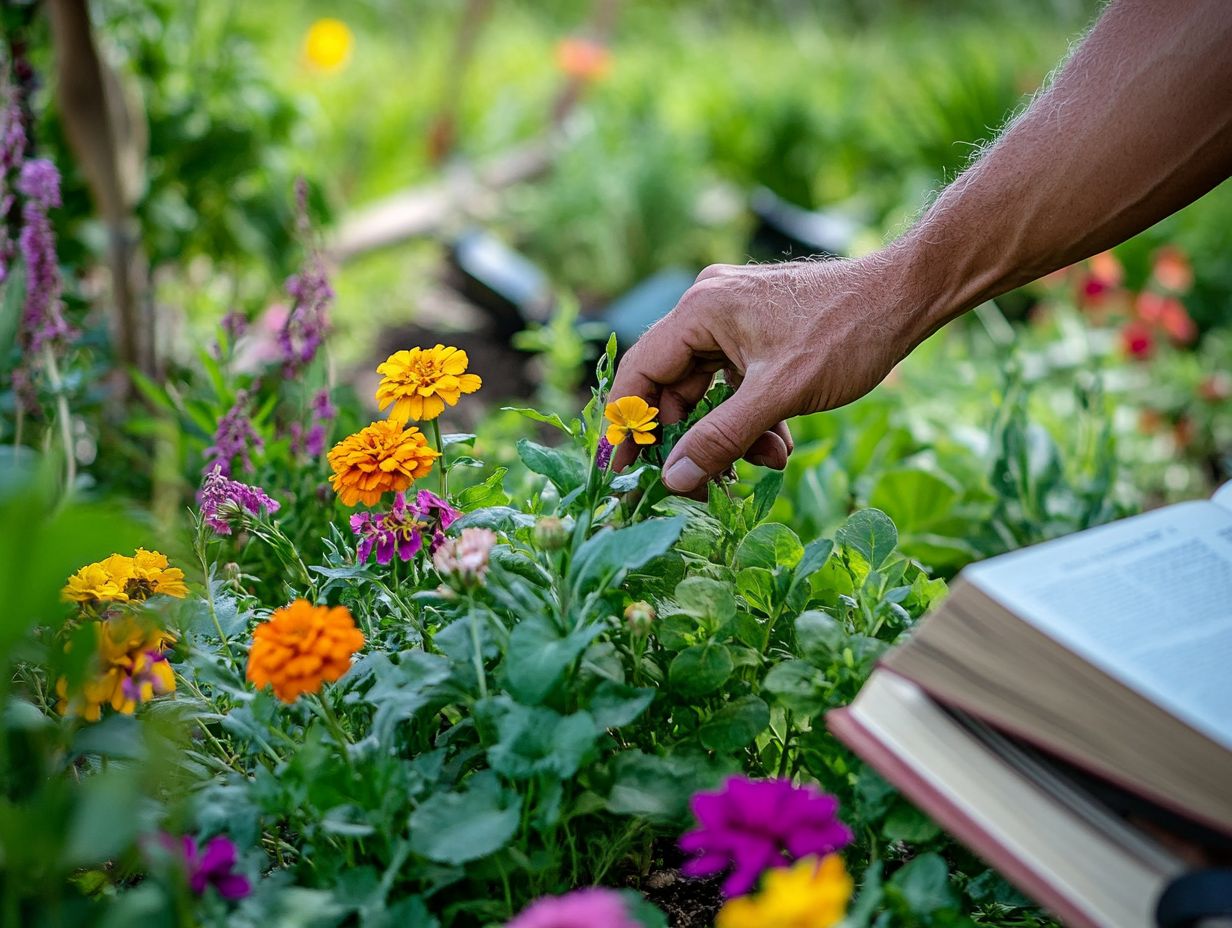
Flowering perennials are a gardener’s dream, celebrated for their vibrant blooms and remarkable variety. They provide essential color and visual interest throughout the growing season, making any garden look better.
These resilient plants dazzle with stunning hues and enhance the overall aesthetic of your garden. Take lavender and coneflower, for example; they bloom from mid-summer to fall, attracting pollinators and creating a lively ambiance that breathes life into your space.
Try adding peonies and daylilies to craft a layered landscape that flourishes across different seasons. This ensures a continuous display of beauty. Combining these perennials with decorative grasses adds movement and depth, culminating in a harmonious, year-round colorful escape that beckons you to enjoy nature.
Foliage Perennials
Foliage perennials are critical in your garden design. They offer a rich tapestry of textures and colors that enhance the structure and depth of your landscape year-round.
These resilient plants do more than catch the eye; they form a lush backdrop for your seasonal blooms. Consider varieties like Hostas, with expansive leaves and vibrant greens, or Sedum, celebrated for its succulent foliage both elevate the charm of your landscape.
Try adding Heuchera for a pop of color! Its diverse leaf colors can create striking contrasts that enhance your aesthetic. The versatility of foliage perennials enables you to cultivate a cohesive look, ensuring your garden remains vibrant and engaging.
Designing Your Perennial Garden
Planning your perennial garden is key to a stunning outcome. Consider both the layout and the selection of complementary plants.
This thoughtful approach helps you create a cohesive and stunning landscape that thrives beautifully over time. A well-thought-out layout is essential for a visually stunning and functional perennial garden.
Creating a Layout and Choosing Complementary Plants
This process involves arranging the plants and paying attention to the interplay of colors and textures. Envision pairing vibrant purple coneflowers with soft white daisies; the contrast draws the eye and ignites interest.
The lush foliage of ferns can enhance the elegance of flowering plants like astilbe. This adds depth and layers to your garden design.
By incorporating varying heights and shapes while ensuring that color schemes harmonize, you cultivate a dynamic and inviting space. This thoughtful approach not only elevates aesthetic appeal but also fosters a thriving ecosystem.
Tips for Maintaining a Perennial Garden
- Embrace specific practices such as pruning.
- Regularly water your plants.
- Fertilize to promote growth.
Maintaining a perennial garden demands a thoughtful approach to ensure its health and longevity. These vital activities help cultivate a vibrant and flourishing landscape that delights the eye and thrives season after season.
Pruning, Watering, and Fertilizing
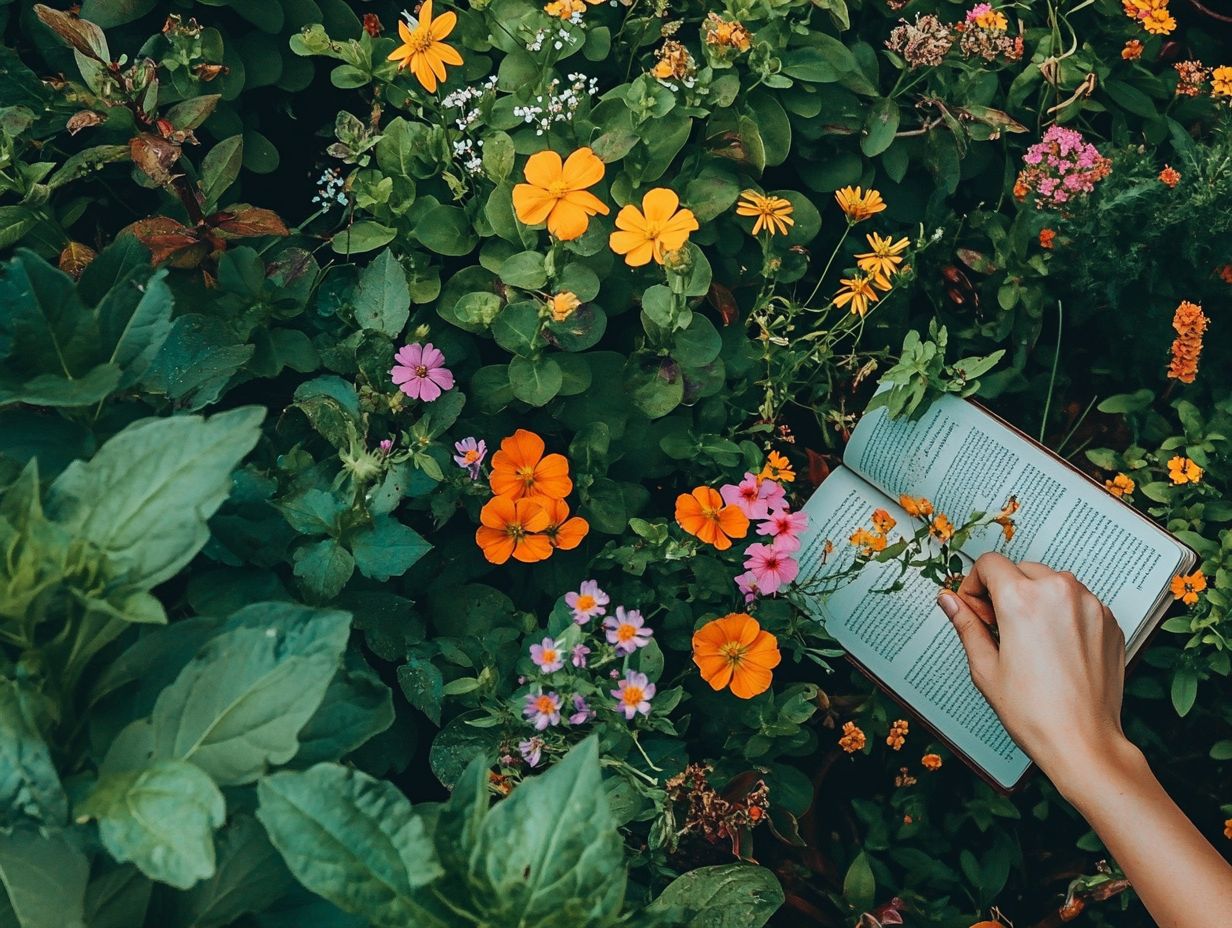
Pruning, watering, and fertilizing are essential practices for maintaining your perennial garden. These activities enhance the beauty of your garden and promote the longevity and productivity of your plants.
Proper pruning removes dead or diseased wood. It encourages new growth and improves air circulation, helping to prevent fungal infections. Regular watering establishes a solid foundation that prevents stress and supports strong root development. Meanwhile, the careful use of fertilizers provides the necessary nutrients, resulting in lush foliage and abundant blooms.
For the best results, prune during the right seasons, water deeply but infrequently, and choose fertilizers based on soil tests to meet your plants’ needs.
Frequently Asked Questions
How do I select the right plants for my perennial garden?
To select the right plants for your perennial garden, consider the climate, soil type, sun exposure, and water requirements of the plants you are interested in. It’s also important to choose plants that will complement each other in height, color, and bloom time.
What are some low-maintenance plants that are suitable for a perennial garden?
Some low-maintenance plants that are great for a perennial garden include:
- Coneflowers
- Black-eyed susans
- Daylilies
- Yarrow
These plants are hardy, require minimal care, and attract pollinators.
How can I ensure my perennial garden has color all year round?
Keep your perennial garden bursting with color all year long by choosing plants that bloom at different times. This provides a continuous display of colors, even during the colder months. Incorporate plants with interesting foliage or evergreen varieties.
What are some ways to incorporate variety in my perennial garden?
There are several ways to incorporate variety in your perennial garden:
- Mix in different plant heights, textures, and colors.
- Include plants with various bloom times.
- Incorporate non-flowering plants such as ornamental grasses.
How can I make sure my perennial garden is sustainable?
To make your perennial garden sustainable, choose plants native to your area, as they are naturally adapted to the climate and require less maintenance. Additionally, consider using organic fertilizers and pest control methods to minimize chemical use.
What are some must-have plants for a beginner’s perennial garden?
For a beginner’s perennial garden, start with low-maintenance plants that are easy to grow. Some must-have plants include:
- Hostas
- Peonies
- Sedums
- Coreopsis
These plants are hardy and forgiving, making them perfect for novice gardeners.
Don’t wait! Choose the right plants today for a stunning garden tomorrow.

